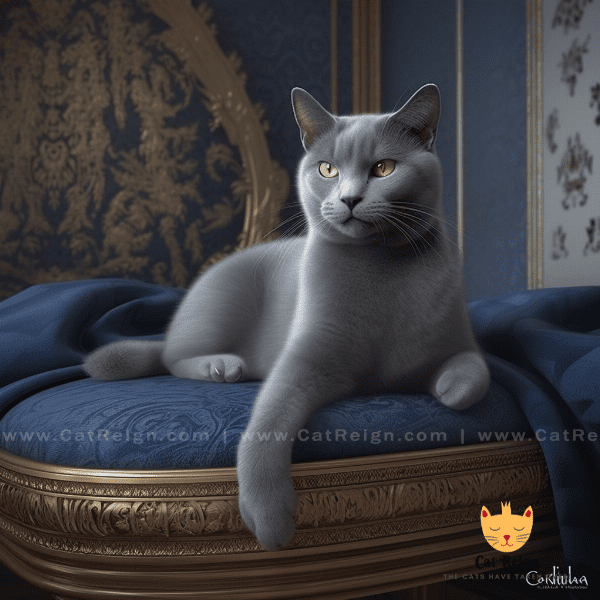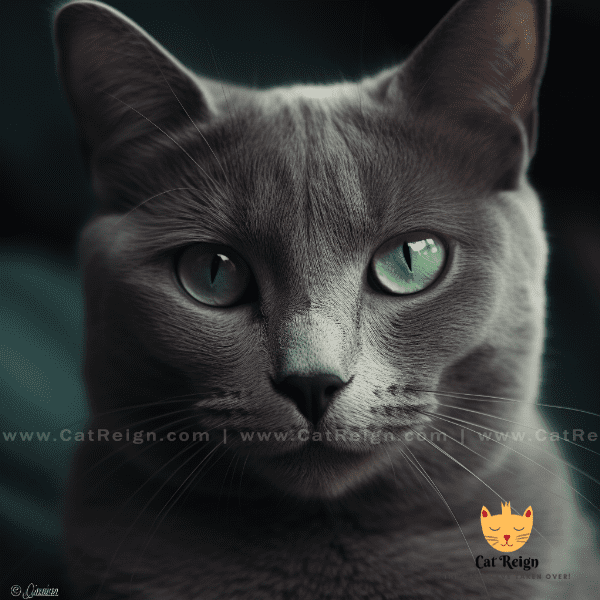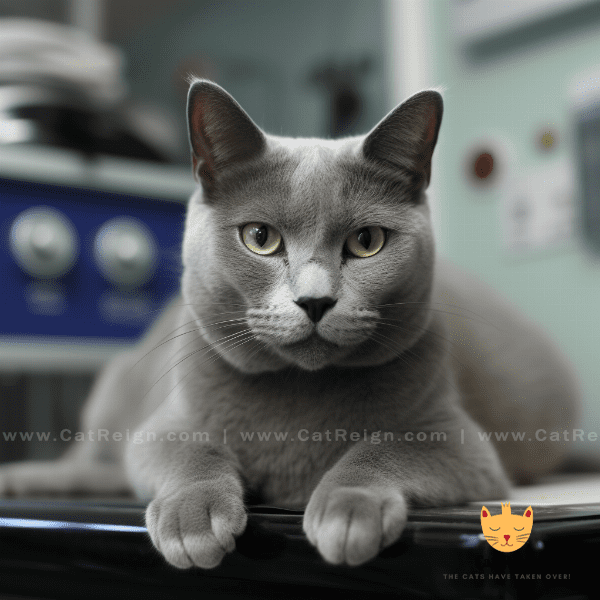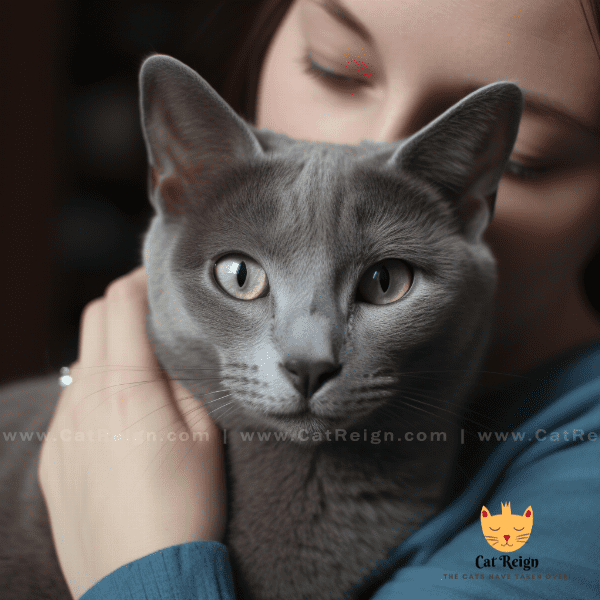Table of Contents
- The History of Russian Blue Cats
- Physical Characteristics of Russian Blue Cats
- The Personality of Russian Blue Cats
- Living with a Russian Blue Cat: Tips and Tricks
- Russian Blue Cat Health Concerns
- Russian Blue Cat Nutrition and Diet
- Grooming Your Russian Blue Cat
- Training Your Russian Blue Cat: Dos and Don’ts
- Bonding with Your Russian Blue Cat
- Finding the Perfect Russian Blue Cat for Your Home
The History of Russian Blue Cats
Russian Blue Cats have a fascinating history that can be traced back to the 19th century in Russia. The exact origins of the breed are still somewhat of a mystery, but there are a few theories.
A Royal Feline
One theory suggests that the Russian Blue was once the favorite feline of Russian royalty. These elegant cats were often kept in palaces and were even given as gifts to other royal families. Their striking blue coat and captivating green eyes made them a sought-after breed among the aristocracy.
A Seafarer’s Companion
Another theory suggests that Russian Blue Cats originally lived aboard ships. Sailors would bring them on long voyages to keep them company and to control the ship’s rodent population. Over time, these cats became known for their loyalty and affectionate nature.
A Breed with a Mysterious Past
Despite these theories, the exact origins of the Russian Blue Cat remain somewhat of a mystery. It’s believed that the breed was first shown at the Crystal Palace Cat Show in London in 1875, but their origins before that point are unclear.
The Russian Blue Today
Today, the Russian Blue Cat is beloved by cat enthusiasts around the world. They’re known for their elegant appearance, quiet demeanor, and loyal personalities. Whether you’re looking for a lap cat or a companion for your long voyages, the Russian Blue is an excellent choice.

Physical Characteristics of Russian Blue Cats
Russian Blue Cats are a medium-sized breed with a distinct appearance. Here are some of their physical characteristics:
Distinctive Coat
One of the most distinctive features of the Russian Blue Cat is its coat. It’s a short, thick, and dense coat that is soft to the touch. The coat is a striking blue-gray color, which gives the breed its name. The coat is also hypoallergenic, making it a great choice for those with allergies.
Muscular Build
Russian Blue Cats have a muscular build that gives them a sturdy and athletic appearance. They have a long and graceful neck, a broad chest, and strong legs. Their paws are small and round, with tufts of fur between the toes.
Striking Eyes
Another distinctive feature of the Russian Blue Cat is its eyes. They are large, round, and a vivid green color. The eyes are set wide apart on the head, giving the cat an alert and intelligent expression.
Compact Size
Despite their muscular build, Russian Blue Cats are relatively compact in size. They typically weigh between 8-12 pounds and have a lean and agile body type.
Overall, the physical characteristics of the Russian Blue Cat give it a unique and elegant appearance that is sure to turn heads.

The Personality of Russian Blue Cats
Russian Blue Cats are known for their unique personalities and charming demeanor. Here are some of the traits that make them so special:
Intelligent and Curious
Russian Blue Cats are highly intelligent and curious animals. They love to explore their environment and are always on the lookout for new things to discover. They’re also great problem-solvers, so don’t be surprised if your Russian Blue figures out how to open doors or drawers.
Independent but Affectionate
While Russian Blue Cats are independent animals, they’re also very affectionate with their owners. They love to cuddle up with their humans and will often follow them around the house. However, they’re not clingy cats and are perfectly happy spending time alone.
Gentle and Quiet
Russian Blue Cats have a gentle and quiet nature that makes them great companions for those who prefer a calmer pet. They’re not prone to excessive meowing or destructive behavior and are generally very well-behaved.
Loyal and Protective
Despite their gentle nature, Russian Blue Cats are fiercely loyal to their owners. They’ll often follow their humans around the house and will even protect them from perceived threats. They’re also great with children and other pets, making them an excellent choice for families.
Overall, the personality of the Russian Blue Cat is what makes them such a beloved breed among cat enthusiasts. They’re intelligent, affectionate, and gentle animals that are sure to steal your heart.

Living with a Russian Blue Cat: Tips and Tricks
Living with a Russian Blue Cat can be a rewarding and enjoyable experience. Here are some tips and tricks to help you make the most of your time with your feline companion:
Create a Safe and Comfortable Environment
Russian Blue Cats thrive in a safe and comfortable environment. Make sure your home is free of hazards and provides plenty of cozy spots for your cat to nap and relax. Consider investing in a cat tree or scratching post to provide your cat with an outlet for their natural scratching behavior.
Provide Plenty of Mental Stimulation
Russian Blue Cats are highly intelligent and curious animals, so it’s important to provide them with plenty of mental stimulation. Toys, puzzles, and interactive playtime can help keep your cat’s mind engaged and prevent boredom.
Establish a Routine
Russian Blue Cats thrive on routine and predictability. Establish a consistent feeding schedule and provide your cat with a designated sleeping area. This will help your cat feel more secure and reduce any anxiety or stress they may experience.
Regular Veterinary Care
Like all cats, Russian Blue Cats require regular veterinary care to ensure they stay healthy and happy. Schedule regular check-ups with your veterinarian and stay up to date on vaccinations and preventative care.
Bond with Your Cat
Bonding with your Russian Blue Cat is an important part of living with them. Spend time playing with your cat, grooming them, and providing plenty of affection. This will help strengthen your bond and ensure a happy and fulfilling relationship.
Living with a Russian Blue Cat can be a wonderful experience. By following these tips and tricks, you can create a safe and happy home for your feline companion.

Russian Blue Cat Health Concerns
Russian Blue Cats are generally healthy animals, but like all cats, they may be prone to certain health concerns. Here are some of the most common health issues to watch out for:
Hypertrophic Cardiomyopathy (HCM)
Hypertrophic cardiomyopathy is a heart condition that is common in Russian Blue Cats. This condition causes the heart muscles to thicken, making it harder for the heart to pump blood efficiently. Regular check-ups with your veterinarian can help catch this condition early and manage it effectively.
Dental Disease
Russian Blue Cats may be prone to dental disease, which can cause gum inflammation, bad breath, and tooth loss. Regular dental check-ups and at-home dental care can help prevent this condition.
Obesity
Like all cats, Russian Blue Cats may be prone to obesity if they’re not provided with proper nutrition and exercise. Obesity can lead to a variety of health problems, including diabetes, joint issues, and respiratory problems.
Urinary Tract Issues
Russian Blue Cats may be prone to urinary tract issues, such as urinary blockages and urinary tract infections. These conditions can be painful and may require veterinary intervention.
Allergies
Some Russian Blue Cats may be prone to allergies, which can cause skin irritation, itchiness, and respiratory problems. If you suspect your cat may have allergies, consult with your veterinarian to determine the cause and develop a treatment plan.
Regular veterinary care and proper nutrition and exercise can help prevent many of these health concerns in Russian Blue Cats. Be sure to schedule regular check-ups with your veterinarian to ensure your cat stays healthy and happy.

Russian Blue Cat Nutrition and Diet
Proper nutrition is essential for the health and well-being of your Russian Blue Cat. Here are some tips for providing your cat with a healthy and balanced diet:
High-Quality Cat Food
When it comes to choosing cat food for your Russian Blue, opt for high-quality, premium brands that are formulated specifically for cats. Look for foods that are rich in protein and low in carbohydrates, as this will help keep your cat’s weight under control.
Wet or Dry Food?
While both wet and dry food can be appropriate for cats, many experts recommend a combination of both. Wet food provides moisture that can help prevent urinary tract issues and digestive problems, while dry food helps keep your cat’s teeth clean and healthy.
Avoid Overfeeding
Russian Blue Cats are prone to obesity, so it’s important to avoid overfeeding. Follow the recommended feeding guidelines on the food packaging and measure out your cat’s meals to prevent overeating.
Limit Treats
While it can be tempting to give your Russian Blue Cat plenty of treats, it’s important to limit them to prevent weight gain. Stick to healthy, low-calorie treats and avoid overindulging your cat.
Fresh Water
Make sure your Russian Blue Cat has access to fresh, clean water at all times. Consider investing in a water fountain, as cats are often more likely to drink from a moving water source.

Grooming Your Russian Blue Cat
Grooming is an important aspect of caring for your Russian Blue Cat. Here are some tips for keeping your cat’s coat and skin healthy and clean:
Brushing
Russian Blue Cats have a short, dense coat that requires minimal grooming. However, regular brushing can help remove loose fur and distribute oils throughout the coat, keeping it healthy and shiny. Use a soft-bristled brush and brush your cat at least once a week.
Bathing
Russian Blue Cats are generally clean animals that don’t require frequent bathing. However, if your cat gets into something particularly dirty or smelly, a bath may be necessary. Use a gentle, cat-specific shampoo and avoid getting water in your cat’s ears.
Nail Trimming
Regular nail trimming can help prevent your Russian Blue Cat from scratching furniture or people. Use cat-specific nail trimmers and trim the tips of the nails. Avoid cutting too close to the quick, which can cause bleeding and pain.
Dental Care
Russian Blue Cats may be prone to dental disease, so it’s important to provide them with proper dental care. Brush your cat’s teeth regularly using a cat-specific toothbrush and toothpaste. You can also provide dental chews or toys to help keep your cat’s teeth clean.
Ear Cleaning
Russian Blue Cats are prone to ear infections, so it’s important to keep their ears clean. Use a cat-specific ear cleaner and a soft cloth to clean the ears. Avoid using cotton swabs, which can damage the ear canal.
By following these grooming tips, you can help keep your Russian Blue Cat healthy and clean. If you have any questions about grooming or your cat’s specific grooming needs, consult with your veterinarian.

Training Your Russian Blue Cat: Dos and Don’ts
Training your Russian Blue Cat can be a fun and rewarding experience. Here are some dos and don’ts to keep in mind when training your cat:
Do Use Positive Reinforcement
Positive reinforcement is a highly effective training method for cats. Use treats, praise, and affection to reward good behavior and encourage your cat to continue the behavior.
Don’t Use Punishment
Punishing your Russian Blue Cat for bad behavior can be counterproductive and may lead to fear or aggression. Instead, focus on redirecting the behavior and using positive reinforcement to encourage good behavior.
Do Be Patient
Training takes time and patience, so don’t expect immediate results. Be consistent with your training and reward even small steps toward the desired behavior.
Don’t Overwhelm Your Cat
Avoid overwhelming your Russian Blue Cat with too much training at once. Break training sessions into short, manageable sessions and gradually increase the difficulty of the behavior.
Do Use Treats Strategically
Treats can be a powerful motivator for your Russian Blue Cat, but it’s important to use them strategically. Use treats to reward good behavior and to encourage your cat to continue the behavior, but don’t rely on treats for everything.
Don’t Train When Your Cat is Uninterested
If your Russian Blue Cat seems uninterested or disengaged during training, take a break and try again later. Training should be a positive experience for both you and your cat, so it’s important to respect your cat’s boundaries.
Training your Russian Blue Cat can be a fun and rewarding experience, but it’s important to use positive reinforcement and be patient. By following these dos and don’ts, you can help ensure a successful training experience for both you and your feline companion.

Bonding with Your Russian Blue Cat
Bonding with your Russian Blue Cat is an important part of building a strong and loving relationship. Here are some tips for bonding with your cat:
Spend Quality Time Together
Spending quality time with your Russian Blue Cat is the best way to bond with them. Play with your cat, cuddle with them, and groom them. This will help build trust and affection between you and your cat.
Respect Your Cat’s Boundaries
While it’s important to spend time with your cat, it’s also important to respect their boundaries. If your cat seems disinterested or wants to be left alone, give them space and try again later.
Provide Plenty of Affection
Russian Blue Cats are affectionate animals that thrive on attention and affection. Provide plenty of petting, snuggles, and praise to show your cat how much you care.
Use Treats and Toys
Treats and toys can be powerful tools for bonding with your Russian Blue Cat. Use treats to reward good behavior and encourage your cat to spend time with you. Toys can provide fun and interactive playtime that strengthens your bond.
Be Patient
Building a strong bond with your Russian Blue Cat takes time and patience. Be consistent with your affection and spend quality time together. Over time, your bond will grow stronger and more meaningful.
By following these tips for bonding with your Russian Blue Cat, you can build a strong and loving relationship with your feline companion. Remember to be patient and respectful of your cat’s boundaries, and always provide plenty of love and affection.

Finding the Perfect Russian Blue Cat for Your Home
If you’re considering adding a Russian Blue Cat to your family, there are several factors to consider to ensure a successful adoption. Here are some tips for finding the perfect Russian Blue Cat for your home:
Consider Your Lifestyle
Russian Blue Cats are relatively low-maintenance, but they still require attention and care. Consider your lifestyle and whether you have the time and resources to care for a cat. If you work long hours or travel frequently, a cat may not be the best choice for you.
Adopt from a Reputable Source
When adopting a Russian Blue Cat, it’s important to adopt from a reputable source. Look for a breeder or rescue organization with a good reputation and positive reviews.
Meet the Cat in Person
Meeting the cat in person is an important step in the adoption process. This will allow you to get a sense of the cat’s personality and temperament and ensure that they’re a good fit for your family.
Consider the Cat’s Age
Russian Blue Cats can live for up to 15 years or more, so it’s important to consider the cat’s age when adopting. A kitten may be a better choice if you’re looking for a long-term companion, while an older cat may be a better choice if you’re looking for a more low-maintenance pet.
Prepare Your Home
Before bringing your Russian Blue Cat home, make sure your home is prepared for their arrival. This includes providing plenty of cozy spots for your cat to nap, litter boxes, scratching posts, and toys.
By following these tips for finding the perfect Russian Blue Cat for your home, you can ensure a successful adoption and a happy and healthy relationship with your feline companion. Remember to do your research and take the time to choose the right cat for your family.




